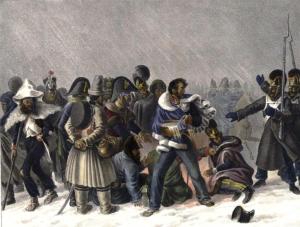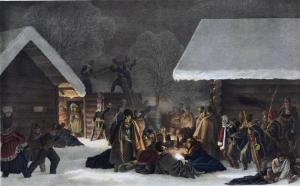The crossing of the Berezina was such a tragic event, that Faber du Faur created four paintings and descriptions to record the drama. Two of the paintings were dated for November 27, 1812.
On the Right Bank of the Beresina, 27 November
“At two in the morning of the 27th the Guard and III corps, including the 25th Division – which, from six regiments of infantry, four cavalry regiments and 1,000 artillerymen, could now scarcely muster 150 men and no guns – broke camp and crossed the bridges to the right bank. All those officers who no longer had men to command followed this movement five hours later. This was a signal for the masses of fugitives camped on the left bank to throw themselves towards the bridges. Dawn saw a confused crowd of men, horses and vehicles pour down towards the bridges, almost as though they were attempting to carry them by assault. Although the enemy was still some distance off, the situation was frightening and the horror of it all was augmented by orders given to the gendarmes and pontonniers not to let anyone pass but armed men or those in formation. All others were pushed back into the crowd, most often by force, and hundreds were crushed underfoot or thrust into the water. Even those who were granted permission to cross the bridges were not entirely out of danger. If they managed to negotiate the slippery ramps they were lucky, but, from there onwards, if they chanced to slip they would certainly be trampled underfoot or pushed into the icy waters of the Beresina.”
“In the midst of the confusion stood the Emperor. He was close by the riverbank, between the two bridges, and he sought to exert some measure of order over the chaos around him. He oversaw the crossing until the evening when, with his suite, he himself made his way to the right bank and established his headquarters in the hamlet of Zaniviki.”
“The majority of our men camped as soon as they got to the right bank. Ignoring everything around them, they thought of nothing but lighting a fire, cooking and warming themselves. Cruel fate! The gusts of snow were so violent that night that it was almost impossible to keep a fire burning. We ourselves had just managed to melt a little snow for drinking water when IX Corps arrived, hustled us out of our camp and obliged us to seek shelter further on.”
Camp on the Right Bank of the Beresina, 27 November
“Forced to abandon our fire, we wandered off in the direction of Zaniviki. We arrived there in the pitch dark with thick snow everywhere. Imperial Headquarters was based here, as was the Guard and a mass of troops and stragglers attracted by the glow of campfires. All the houses were occupied, and it was only after considerable effort, and some hard searching, that we found a house occupied by our staff, officers and soldiers. We had to obtain some wood at gunpoint to feed our fire, and we settled down for the night in the deep snow. There was no food. Soon fighting broke out – not, as one might expect, for room inside the houses but for the houses themselves: the soldiers, maddened by the cold, had clambered onto the roofs and started to demolish the houses for wood. The occupiers fought vainly to prevent this but, by the following morning, Zaniviki had disappeared, consumed by countless campfires.”
Source:
With Napoleon in Russia: The Illustrated Memoirs of Major Faber du Faur, 1812, edited by Jonathan North



